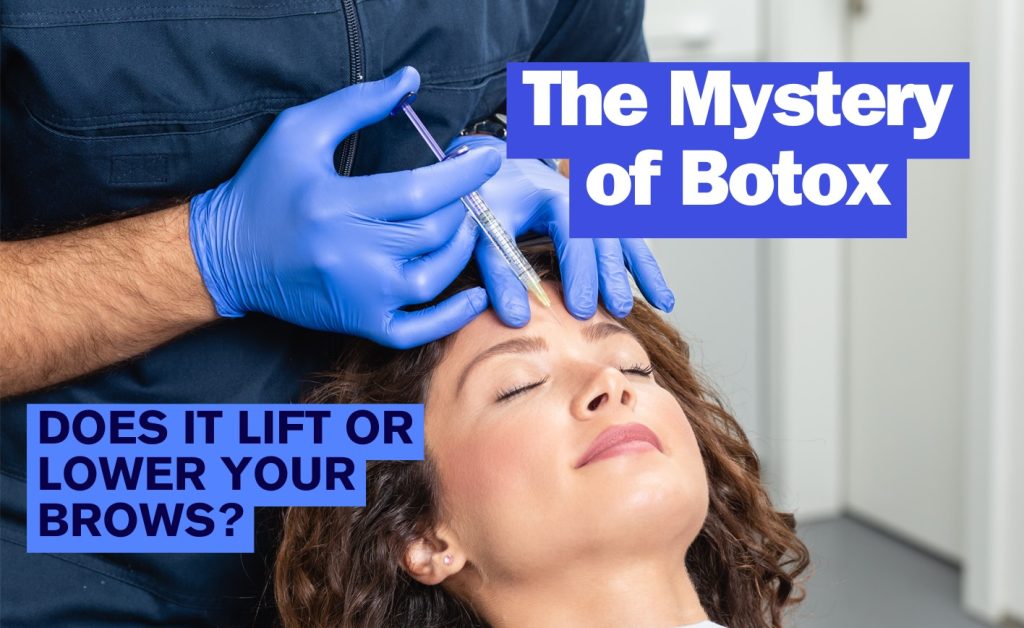Botox is one of the most common aesthetic procedures around, and it continues to grow in popularity with fads like ‘baby Botox’ or ‘Barbie Botox.’ But like any popular cosmetic enhancement, it evolves over time, and desired results differ depending on what’s considered ideal at the time. Though you may never have thought about it before, one of the greatest mysteries that many cannot wrap their minds around is whether Botox is supposed to lift or lower the brows. The answer is complicated – read on to find out more.
How Does Botox Work?
Whenever one moves, muscles work together to engage, contract, lengthen, and relax. The muscles are contracting and relaxing in the opposing fashion in order to produce refined movements. This is called agonist vs. antagonist muscle movement. Whether you’re stretching your shoulder, furrowing your brow, or tying your shoes, agonist and antagonist muscles are hard at work making your body move.
Facial Muscles and Botox
The same idea about agonists and antagonists is applied to muscles in the face. Whenever you grimace, smile, cry, or laugh, muscles in your face are flexing and relaxing to make it happen. Most facial Botox involves three specific muscles. First, the frontalis is a large muscle stretching across your entire forehead. The frontalis is the muscle responsible for lifting your eyebrows – which means it’s also responsible for those pesky forehead creases. Going around the eyes and all the way up to the top of the brow is the orbicularis, which creates crow’s feet and other wrinkles. Then, there’s your glabella muscle (also called the corrugator), commonly known as the ‘frown muscle,’ which is responsible for deep lines between the brows.
A skilled injector will inject Botox into a certain muscle in order to relax them, which in turn minimizes wrinkles in the area. Also, by selectively injecting agonist or antagonist muscles, one can change how the face moves. The most evident example of this is a change in the brow’s position with Botox injections. Brows are lifted or lowered depending where the Botox is injected – if the entire frontalis is injected, the brow lowers. And if frontalis agonists (corrugator and orbicularis) are injected, the brow elevates.
One would think that elevating the brows is a good thing. However, this means that the frontalis muscle is working overtime, and that more forehead wrinkles will form. Plastic surgeons had to come up with a trick to have it both ways – elevating the brows while avoiding having deep wrinkles across the forehead. The trick is to inject the central part of the frontalis muscles, which helps to alleviate the wrinkles, while leaving the outside portion of the muscle active to prevent the brows from drooping.
Trends Changing Over Time
When Botox hit the market and gained popularity in the 1990s, plastic surgeons loved it so much that sometimes, they tended to use it too generously. Every muscle in the forehead would be injected to the point of being completely paralyzed. Those who got Botox during those times quickly found that their brows drooped, as no muscle would hold them in place. And when the goal of plastic surgery is often to tighten, lift, and firm, drooping is the last thing you’d want to see.
As plastic surgeons became more familiar with Botox, Dr. Konstantin says, they realized the injections could smooth out wrinkles without paralyzing the entire frontalis muscle. When the central portion of the frontalis is relaxed, and the outer segment of the muscle is still active, it creates a nice lifting effect and smoothes out the wrinkles at the same time.
Like so many other things in life, the bad always comes with the good, and the bad in this case was creating an unnaturally angular shape. And as more and more people ended up with this specific brow aesthetic, it became recognized as a telltale sign of Botox injection. As the notion of an obviously apparent cosmetic procedure can be undesirable for many, interest in Botox began to waver.
That being said, trends change quickly in the age of social media, and what’s considered out of style will almost always come back into style. With the rise of Instagram and TikTok, aesthetic procedures aren’t just becoming normalized – sometimes, they’re coveted. The ‘angular brow’ that was once a clear sign of one’s Botox, Dr. Konstantin says, is now almost a fashion statement for young social media personalities.
Getting the Most Bang for Your Botox
Everyone’s muscles are different, meaning that no two people will react the same way to Botox. Working with a skilled plastic surgeon, Dr. Konstantin adds, you can make an informed decision based on what would look good with your features – and an experienced injector would know just where to place Botox to have you looking and feeling your best.
If you would like to know more about surgical solutions for Botox, contact us and book a consultation with New York’s top facial plastic surgeon, Konstantin Vasyukevich, MD.


Leave a Reply